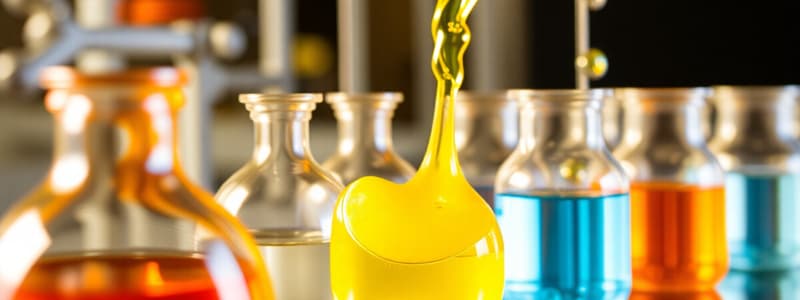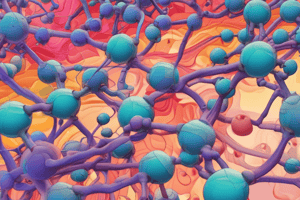Podcast
Questions and Answers
What defines a monomer?
What defines a monomer?
- A simple repetitive unit that forms polymers (correct)
- A complex protein structure
- A large molecular structure
- A type of chemical reaction
What is the Degree of Polymerization (DP)?
What is the Degree of Polymerization (DP)?
- It calculates the ratio of polymers to monomers
- It is the ratio of monomers in a reaction
- It is the number of repeating units in a polymer chain (correct)
- It represents the total mass of a polymer
In the calculation of DP, what is the first step?
In the calculation of DP, what is the first step?
- Multiply the atomic masses by the number of atoms
- Evaluate the molecular weight
- Write the chemical formula of the polymer (correct)
- Determine the atomic mass of elements
How do you calculate the molecular weight of a polymer using DP?
How do you calculate the molecular weight of a polymer using DP?
Which of the following describes high polymers?
Which of the following describes high polymers?
If the molecular mass of tetrafluoroethylene is 120,000 and the molecular weight of the monomer is 100, what is the DP?
If the molecular mass of tetrafluoroethylene is 120,000 and the molecular weight of the monomer is 100, what is the DP?
What is the typical molecular formula of polyethylene represented as?
What is the typical molecular formula of polyethylene represented as?
Which of the following examples illustrates polymerization?
Which of the following examples illustrates polymerization?
What characterizes the processing of thermoplastics in their melt state?
What characterizes the processing of thermoplastics in their melt state?
Which of the following is true about thermosetting polymers?
Which of the following is true about thermosetting polymers?
What is a characteristic of most polymer processing steps?
What is a characteristic of most polymer processing steps?
Which factor is crucial for setting or maintaining the shape in polymer processing?
Which factor is crucial for setting or maintaining the shape in polymer processing?
What is the first step in polymer processing?
What is the first step in polymer processing?
What describes the thermal conductivity characteristic of polymeric materials?
What describes the thermal conductivity characteristic of polymeric materials?
What do the two-dimensional forming processes typically shape?
What do the two-dimensional forming processes typically shape?
What property is typically poor in thermoplastic polymers?
What property is typically poor in thermoplastic polymers?
What happens to viscosity as temperature increases?
What happens to viscosity as temperature increases?
Which of the following factors increases viscosity?
Which of the following factors increases viscosity?
In the injection moulding process, which phase involves transforming the polymer into a melt state?
In the injection moulding process, which phase involves transforming the polymer into a melt state?
What is the primary purpose of the setting phase in injection moulding?
What is the primary purpose of the setting phase in injection moulding?
Which polymer processing method is typically used to produce complex shapes from thermoplastics?
Which polymer processing method is typically used to produce complex shapes from thermoplastics?
What could happen if the hot strength of the polymer is too low during blow moulding?
What could happen if the hot strength of the polymer is too low during blow moulding?
Which type of flow behavior could a polymer dispersion exhibit under certain conditions?
Which type of flow behavior could a polymer dispersion exhibit under certain conditions?
What occurs during the injection phase of injection moulding?
What occurs during the injection phase of injection moulding?
Which polymer is predominantly used for its excellent barrier properties in packaging carbonated drinks?
Which polymer is predominantly used for its excellent barrier properties in packaging carbonated drinks?
Which polymer is preferred for manufacturing large water bottles due to its impact resistance?
Which polymer is preferred for manufacturing large water bottles due to its impact resistance?
What is the main application of polystyrene in packaging?
What is the main application of polystyrene in packaging?
Which technique is among the most common for thermal polymer characterization?
Which technique is among the most common for thermal polymer characterization?
Which of the following has largely taken over the market for transparent rigid PVC bottles?
Which of the following has largely taken over the market for transparent rigid PVC bottles?
What is one of the uses of Thermogravimetric Analysis (TGA) in polymer analysis?
What is one of the uses of Thermogravimetric Analysis (TGA) in polymer analysis?
In which application would polyethylene and polypropylene be primarily utilized?
In which application would polyethylene and polypropylene be primarily utilized?
Which polymer is known for being a lightweight, low-cost material used in various consumer applications?
Which polymer is known for being a lightweight, low-cost material used in various consumer applications?
What is the primary definition of a polymer?
What is the primary definition of a polymer?
What does the term 'mer' refer to in the context of polymers?
What does the term 'mer' refer to in the context of polymers?
Why can the term 'polymer' be a synonym for 'plastic'?
Why can the term 'polymer' be a synonym for 'plastic'?
How is the degree of polymerization defined?
How is the degree of polymerization defined?
In terms of atomic structure, what does the mass number indicate?
In terms of atomic structure, what does the mass number indicate?
What is the atomic number of the carbon atom?
What is the atomic number of the carbon atom?
Given that cobalt has an atomic number of 27 and 33 neutrons, what is its mass number?
Given that cobalt has an atomic number of 27 and 33 neutrons, what is its mass number?
Which of the following correctly describes a characteristic of polymers?
Which of the following correctly describes a characteristic of polymers?
Flashcards are hidden until you start studying
Study Notes
Polymers
- Polymers are high molecular weight compounds formed by the repeated union of simple molecules called monomers.
- Common examples include starch, polyvinyl chloride, polyethylene, and Nylon 6,6.
- The term "polymer" comes from the Greek words "poly," meaning many, and "mer," meaning unit or part.
Key Terms
- Mer: The repeating unit in a polymer chain.
- Monomer: A single mer unit (n=1).
- Polymer: Many mer-units along a chain (n=10^3 or more).
- Degree of Polymerization: The average number of mer-units in a chain.
Atomic Number and Mass Number
- Atomic Number: Number of protons in a particular atom of an element.
- Mass Number: Total number of protons and neutrons in an atomic nucleus.
Polymerization
- The process of forming polymers from monomers.
- Examples: The transformation of ethylene to polyethylene and the interaction of hexamethylene diamine and adipic acid to form Nylon 6,6.
Monomers
- A simple repetitive unit that combines to form a polymer.
- Examples include vinyl chloride, ethene, and propylene.
Degree of Polymerization
- The number of repeating units (n) (monomers) in a polymer chain.
- DP = n.
- Calculation:
- Divide the molecular mass of the polymer by the molecular weight of the monomer.
- Example: If the molecular mass of tetrafluoroethylene is 120,000 and the molecular weight of the monomer is 100, the DP would be 1,200.
Types of Polymers
- High Polymers: Polymers with a high degree of polymerization.
- Oligopolymers: Polymers with a low degree of polymerization.
Characteristics of Polymers
- Generally have low density, poor tensile strength, low coefficient of friction, and poor temperature resistance.
- Offer good corrosion resistance, mold ability, and can be produced in transparent or various colors.
Polymer Processing
- Stages:
- Mixing Additives: Additives are mixed with the polymer to achieve desired property modifications.
- Forming: Creation of the desired shape, divided into 2D and 3D forming for products with simple and complex geometries, respectively.
- Setting: Maintaining the shape through cooling or chemical processes.
Common Polymer Processing Techniques
- Heat Transfer: Polymeric materials are heated to achieve a softened state.
- Flow and Deformation (Rheology): In the melt state, thermoplastics exhibit varying resistance to flow, which is influenced by factors like temperature, pressure, molecular size, and additives.
- Extrusion: A continuous process that converts polymers into products with controlled cross-sections.
- Injection Molding: A process used for producing complex shapes by injecting melted polymer into a mold cavity.
Injection Molding Phases
- Plasticisation: Transforming polymer granules into a homogeneous melt.
- Injection: Transferring the melt into the mold cavity.
- Setting: Cooling the melt to solidify.
- Ejection: Removing the finished product from the mold.
Blow Molding
- Used for producing hollow objects, such as bottles.
- Commonly used materials include polyethylene, polypropylene, polystyrene, PVC-u, polycarbonate, and polyethyleneterephthalate (PET).
Applications of Polymers
- Packaging: Used extensively for food containers, bottles, and packaging materials.
- Medicine: Used in biomaterials, such as artificial heart valves and blood vessels.
- Consumer Science: Light-weight and cost-effective containers for various consumer products.
- Industry: Used in manufacturing automobile parts, pipes, tanks, and packaging materials.
- Sports: Used in playground equipment, sporting gear, and helmets.
Polymer Analysis Techniques
- Chromatographic polymer characterization: Uses techniques like chromatography to separate and identify individual components within polymers.
- Thermal polymer characterization: Uses techniques like Differential Scanning Calorimetry (DSC) and Thermogravimetric Analysis (TGA) to study the thermal properties of polymers, including glass transition temperature (Tg), melting temperature (Tm), and crystallization temperature (Tc).
Studying That Suits You
Use AI to generate personalized quizzes and flashcards to suit your learning preferences.





